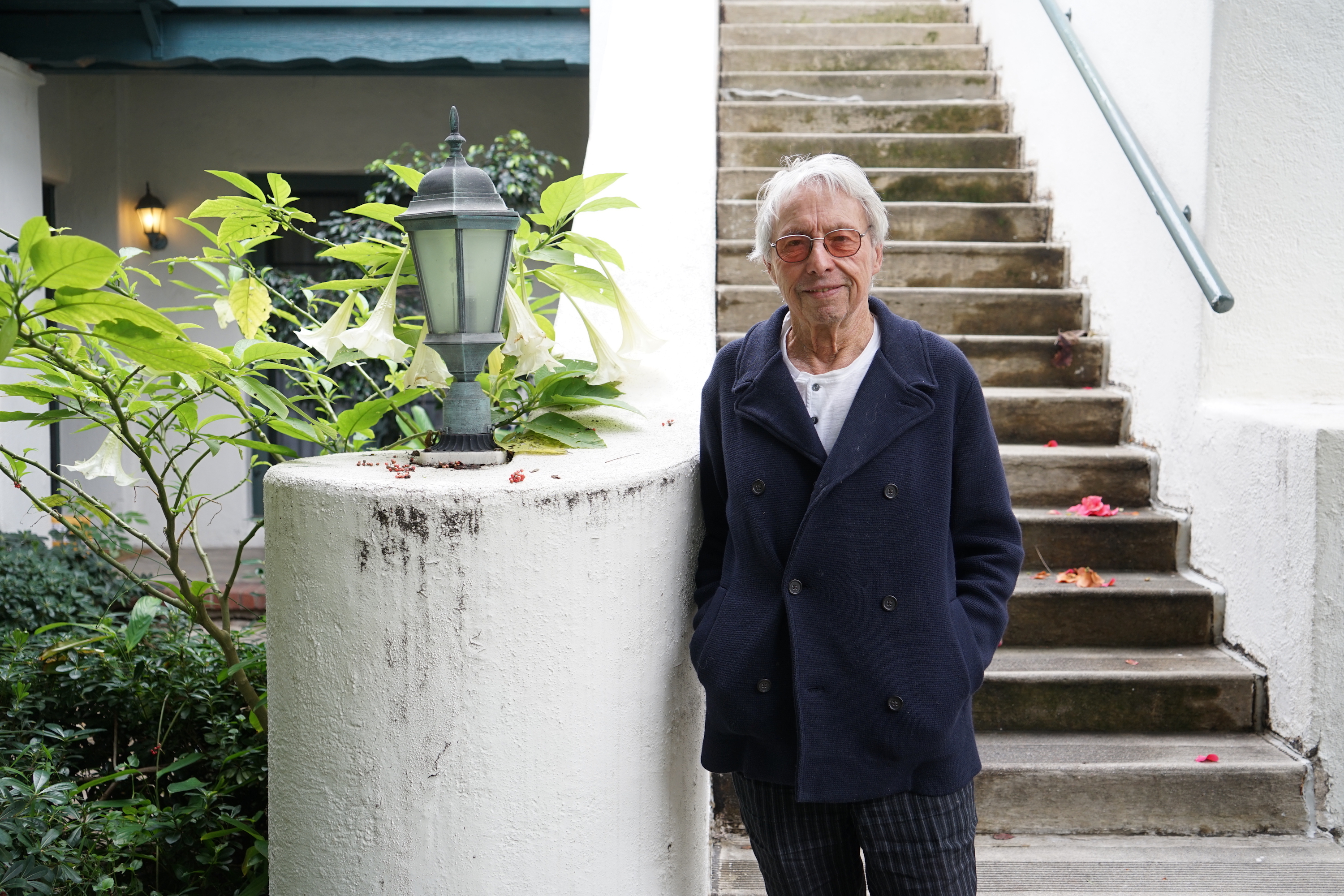Revolutionary Arseny Avraamov

The tumultuous life and pioneering work of the composer and theorist who wanted to burn all pianos in Russia
A composer, music journalist, theorist and outspoken critic of the classical 12-tone system, Arseny Avraamov was a Russian artist whose life and work was so adventurous it couldn’t be contained under a single name. At various points from his birth in 1886 until his death in 1944, the self-taught acoustician lived as Ars, Arslan-Ibrahim-ogli Adamov, Dimitry Donskoy, Axel Smith, Regent, Perditur and, perhaps most memorably, Revarsavr: Revolutionary Arseny Avraamov.
The last was a suitable nickname for the multifaceted intellectual, whose inventions, performances and musicological insight constituted an invaluable contribution to the history of recorded music both in Russia and beyond.
Sequencers, multi-channel recordings, sound editing... It all sprung, at least in part, from Avraamov.
But it wasn’t entirely clear early on that Avraamov would grow up to become interested in music. Instead, most of his early life was spent thinking about politics.
As a teenager, Avraamov studied military affairs, starting in the Donskoy Cadet Corps and then moving to the Mikhailovsky Artillery School. He felt stifled by school, though, and did everything in his power to get expelled. This restlessness coincided with political stirrings that eventually found Avraamov campaigning for Communism, and he put his thoughts on the existing state system into a speech in which he decried the state of both these schools and the military complex at large. He was labelled a dangerous revolutionist and placed under police supervision, ending his military career before it began, and he took to campaigning further for social democracy as part of the student organization “Overt Surveillance” in various Russian towns through the autumn of 1904.
Avraamov’s political activity ramped up once he moved to Ukraine to attend the Kiev Polytechnical Institute, a period of study that ended after six months when the institute was closed due to student unrest. On January 15, 1905, Arseny participated in the seizure of the institute building, armed with hoses and homemade chemical bombs. The police and army forces were able to subdue the students, but the action mostly ended when a Supreme Manifesto of the Improvement of Public Order was signed on October 17, 1905 by Emperor Nicholas II, in an effort to create a type of binding constitution. Avraamov got back to Novocherkassk, making a speech in support of Communism almost immediately upon his arrival and decamping to Rostov thereafter.
En route back to Kiev, Avraamov received a Mauser rifle as a gift from a sympathetic Armenian terrorist – he would go on to keep the gun nearby for years to come as his political engagement increased and he came under further scrutiny. But he found relative peace in the Ukraine, where party comrades gave him a new name on a fake passport – Dimitry Ivanovich Donskoy – as well as a fake wife to cement the reliability of the new identity.
Like most of Avraamov’s peacetime life, this period was short-lived: On November 18th, 1905, an armed insurrection broke out in Kiev and Avraamov was forced to flee. The local Communist party was crushed, and bomb-making materials were found in the laundry basket of Avraamov’s apartment. He would return to Russia in the spring of 1906, still only 20 years old, deciding to leave his political past behind, erase Dimitry Donskoy and focus on a surprising new area: music.
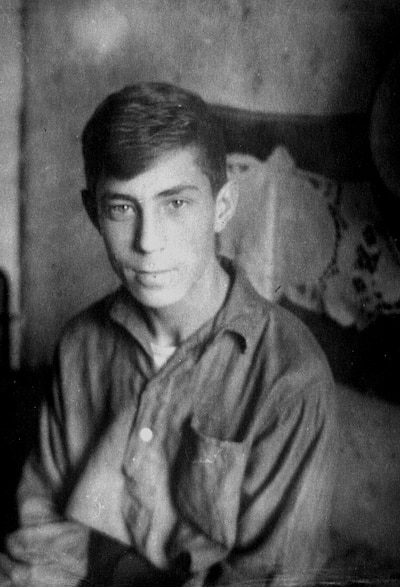
From 1908 to 1911 Avraamov studied music theory under professors Ilya Protopopov and Arseny Koreshchenko at the Moscow Philharmonic Society, as well as taking private composition lessons with composer Sergei Taneyev. In 1910, he became involved in various publications as a music critic, publishing under the pseudonym Ars. But before long his past caught up to him, and in 1912, while serving in the Cossack military division, he was arrested and imprisoned for propaganda.
Eventually, he landed in St. Petersburg. When he arrived, despite his scattered biography to that point, it was clear that Avraamov had made a name for himself in his short time as a music critic and theorist. Composer Nikolai Roslavets was effusive in a letter of support, addressed to Nikolai Kulbin, in which Roslavets asked Kulbin to take care of his friend Arseny Avraamov, “the skilled musician and the most talented journalist writing mainly concerning art.” Roslavets wrote further: “It is that Avraamov about whom I spoke with you when I stayed in St. Petersburg – the propagandist of the natural (overtone-based) scale in music and the inventor of corresponding musical tools.”
Once settled in St. Petersburg, then Petrograd, from 1914 to 1916 Avraamov gradually re-entered the society of thinkers and composers he’d left behind, joining the editorial boards of the magazines Muzikalni Sovremennik (Musical Contemporary Magazine) and Letopis (The Chronicle). In parallel in Moscow he was an employee of Muzika magazine, where over a series of articles he developed the theory of microtonal “ultrachromatic” music and invented special instruments to perform it.
It was in 1916 that Avraamov first suggested an approach to sampling, analyzing, processing and resynthesizing sounds. In the article Upcoming Science of Music and the New Era in the History of Music, Avraamov noted that “By knowing the way to record the most complex sound textures by means of a phonograph, after analysis of the curve structure of the sound groove, directing the needle of the resonating membrane, one can create synthetically any, even the most fantastic sound by making a groove with a proper shape, structure and depth...” Moreover, Avraamov proposed a method of sound synthesis based on mathematical modeling of acoustical properties of sounding objects that is quite similar to today’s techniques of physical modeling. In other words, Avraamov was predicting the development of synthesizers in their modern form.
Avraamov’s article called to unite the efforts of all of those who believed in the importance of scientific analysis to support the theory of music. This, in some part, came to pass in the Leonardo da Vinci Society, which was founded in St. Petersburg in the spring of 1917 by Avraamov, inventor Evgeny Sholpo and the young mathematician and musicologist Sergei Dianin. Their principles, taken from da Vinci, were a belief in the power of science, and aspiration to objective knowledge of the “mysterious” laws of art. They wanted to produce a revolution in music theory and techniques based on the cross-connection of the arts and sciences.
Case in point: Shortly after the October Revolution in 1917, Avraamov proposed to the Commissar of Public Enlightenment, Anatoly Lunacharsky, a project to burn all pianos in Russia. Avraamov perceived pianos as the ultimate symbols of the despised 12-tone, octave-based “well-tempered” scale, which he believed had adversely affected human hearing for several hundred years. Arguing in favor of the new 48-tone, microtonal, ultrachromatic scale named the “Welttonsystem,” Avraamov intended to pursue the possibility of combining the well-tempered scale with the natural one based on series of overtones.
Of all the early pioneers of microtonal music, Avraamov alone pursued this approach to erase the difference between pitch-based harmony structures and the spectral tissue of sound. He envisioned future ultrachromatic musical instruments not so much as a way to reach the new microtonal harmony but as a way to realize exciting possibilities of additive synthesis.
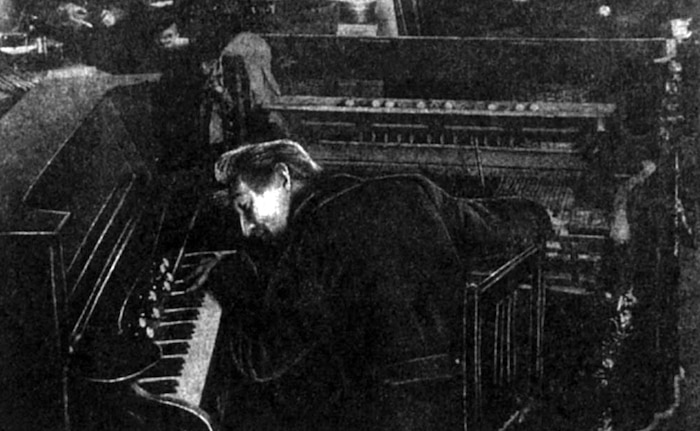
During the 1920s Avraamov experimented with specially prepared “re-tuned” pianos, harmoniums and various noise sources as well as a symphony orchestra to develop new approaches to organizing sound. According to Avraamov, “My principle position follows on from my acoustic approach, which erases a contradiction between musical and noise effects. Both are organized sound, but organized differently. Clearer composition led to a musical effect, which became more complex, and when explored further, led to effects of the noise kind.”
In Russia in the early 1920s, performances by the Foregger Studio as well as experiments at the Eisenstein Studio led a trend towards an embrace of noise music and, more specifically, noise orchestras. As René Fülöp-Miller noted in 1926: “The same idea also ruled the true proletarian music: it, too, emphasized the rhythms which corresponded to the universal and impersonal elements of humanity. The new music had to embrace all the noises of the mechanical age, the rhythm of the machine, the din of the great city and the factory, the whirring of driving-belts, the clattering of motors, and the shrill notes of motor-horns.”
Therefore, the Bolshevists very soon proceeded to construct special noise instruments, to form noise orchestras, to give the public a “real new music.” They imitated all conceivable sounds from industry and technology and united them in peculiar fugues, in which a whole world of noise deafened the ear. In increasingly extended forms, the new “machine music” made itself felt, and soon noise symphonies, noise operas and noise festive performances were composed.”
One example of this trend was Noiserhythmusic (Shumrhithmuzika) composed by Avraamov in November 1923 for Sergei Tretjakov’s “Do You Hear, Moscow?,” performed by the First Worker’s Theatre of Moscow Proletkult, staged by Sergei Eisenstein. Avraamov explains: “I am writing the most amusing score for the interlude between the second and third parts of ‘Do You Hear, Moscow?’ During the construction of a speaker’s platform for the third part: ‘Noiserhythmusic’ of carpenter’s tools: two files, a manual saw and a mechanical one, a grinding wheel, axes, hammers, sledge hammers, logs, nails, planes, chains and so forth will sound. At the same time there will be no embellishments – just the original work copied rhythmically and harmoniously.”
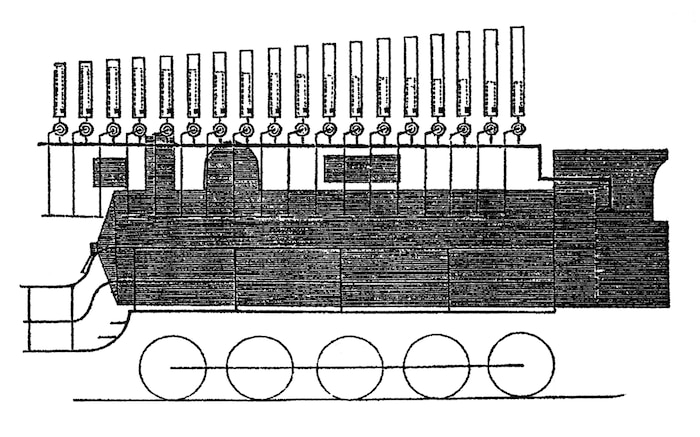
Even earlier, in 1922, Avraamov proposed a project using a “Steam Organ” as a mobile instrument, based on numerous locomotive whistles specially tuned in his ultrachromatic scale. An electrified musical keyboard controlled the electric valves, which in turn activated the whistles mounted in the cabin of the locomotive driver.
In 1923, working on the draft program of GIMN (The State Institute for Musical Science), Avraamov proposed a project named “Topographical Acoustics.” He suggested building powerful electroacoustic systems that could be installed on airplanes, from which vast areas of land could be covered with sound. He noted in 1927: “And if the sound of sirens is not powerful and qualitative enough, what could we dream about? Clearly: about the devices of Theremin or Rzhevkin, installed on aeroplanes, flying above Moscow! An Aerosymphony!”

To commemorate the fifth anniversary of the October Revolution, on November 7th, 1922, Avraamov staged his most famous work, “The Symphony of Sirens,” in the port town of Baku. The epic spectacle featured a cast of choirs, the foghorns of the entire Caspian flotilla, two batteries of artillery guns, a number of infantry regiments (including a machine-gun division), hydroplanes and all of the town’s factory sirens. The conductor, posted on a purpose-built tower, signalled various sound units using colored flags and field phones, while a central sound-machine called the “Magistral” contained 50 steam whistles, controlled by 25 musicians following text scores. The performance was mounted on the torpedo boat Dostoyni, where 25 musicians played locomotive whistles.
Despite the apparent chaos, Avraamov had a distinct reason and cogent justification for his use of instrumentation with such unorthodox firepower: “Because of the big area of distribution of the factory sirens,” he explained in Gorn magazine in 1923, “it is necessary to have at least one heavy gun for signalling purposes with the capacity to shoot live cartridges. (Shrapnel is not suitable for this – bursting off in the air is most dangerous and gives a second explosion sound, which can confuse the performers.) The ‘big drum’ can be provided by field artillery as well. Skilled machine gunners, when shooting with a live cartridge belt, not only simulate a drumbeat, but also beat out complex rhythmic figures. A gun shooting with blank cartridges as well as gunfire with frequent packs are good for vivid scene sounds.”
Andy Mackay, in his book Electronic Music, called the performance one of the most impressive experiments with noises and natural sounds in avant-garde history: “Sirens of urban factories were joined by sirens of the ships of the Caspian fleet, artillery battery, machine guns and aircraft.”
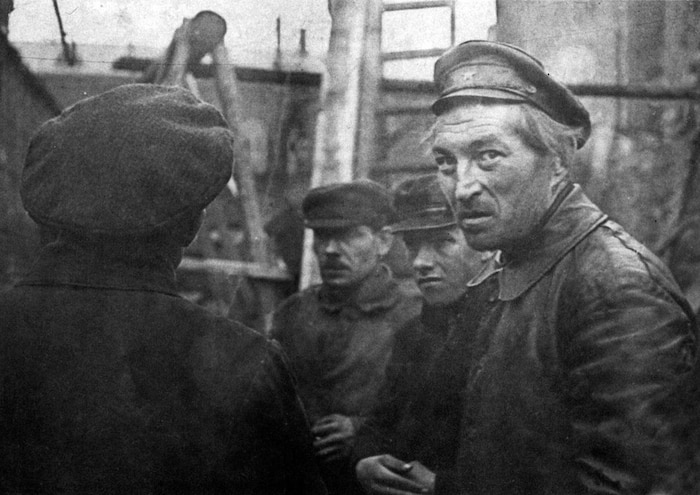
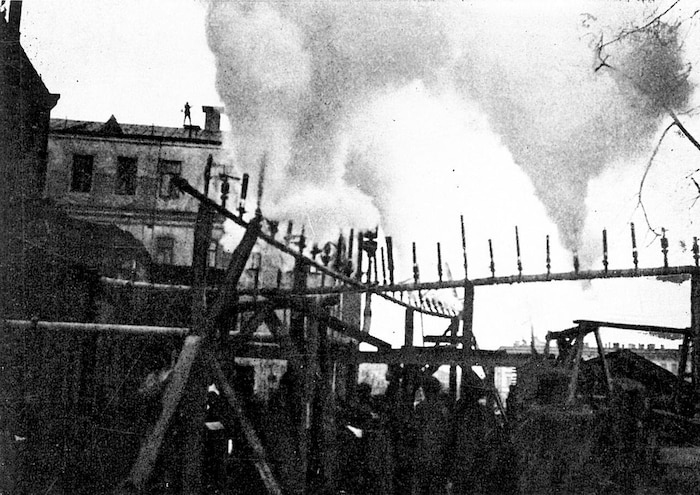
The second performance of “The Symphony of Sirens” took place a year later on the same day in Moscow, presented in the yard of the central thermal power station MOGES. However, because of the enormous area over which the sirens and artillery were spread, the spatial conditions of this second performance were less than ideal. The contributing military divisions also lacked sufficient ammunition, while an overlapping demonstration dedicated to the sixth anniversary of the October Revolution contributed additional unwanted noise. According to Avraamov, “They gave us only 27 heavy gunshots! It is for the big drum! And there were no machine guns at all... only gunfire! And there were two dozen aeroplanes buzzing over Red Square.”
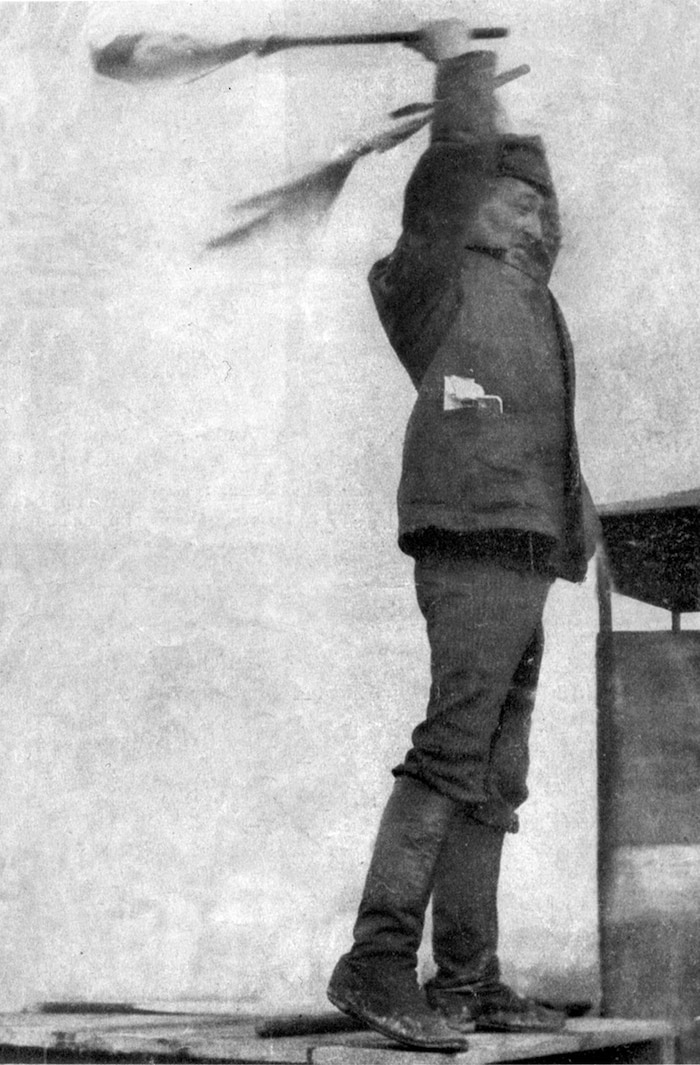
Despite the apparent pomp-and-circumstance that marked Avraamov’s return to Moscow, it masked an inconvenient truth – by 1923 Avraamov was homeless and destitute, spending the majority of his nights in the famous Pegasus Stall cafe, which was run by a sympathetic group of futurists. “The only advance payment I received from publishers I have spent on an overcoat, etc...” he says in private correspondence with Rebecca Zhiv. “It was necessary. I eat at the Pegasus Stall – the cafe of the Imaginists – gratis, on account of future blessings, lodging for the night in a separate cabinet. In a word, I am sharing the stable with Pegasus.” His circumstances eventually improved: Avraamov secured a job at the State Institute for Musical Science in Moscow, where he remained until 1926.
On June 1st, 1927, Avraamov initiated yet another phase of his creative life with the formation of the Association for the Revival of Music, an attempt to continue the philosophical and compositional traditions of the Leonardo da Vinci Society. The updated membership of the Association included such luminaries as Leon Theremin – the leading musical technologist of the time, in Russia or anywhere else – and a forward-thinking cultural manager, the commissar Boris Krasin. Still, the project was short-lived. Shortly after its formation, Theremin’s chief professor Abram Ioffe was able to patent his namesake instrument invention, and sent Theremin on an international trip in Europe and the United States, leaving the association dead in the water without one of its key contributors.
Undeterred, Avraamov went to work at the State Institute for History of Arts in Leningrad, and later in the summer he was sent, alongside Theremin, to represent the Soviets at the International Music Exhibition in Frankfurt am Main, Germany. It was here that Avraamov finally presented his grand vision of the universal, 48-tone “Welttonsystem.”
Meanwhile, the new era of sound cinema was emerging, and once again Avraamov found himself on the cutting-edge of contributions to a nascent field. As part of the group working on the Soviet Union’s first experimental sound movie Piatiletka: The Plan of Great Works in 1929, Avraamov was based in Leningrad at Shorin’s Central Laboratory of Wire Communication, on a team that included the inventor Evgeny Sholpo and the painter, illustrator and animator Mikhail Tsekhanovsky. The team struggled to create a soundtrack that would satisfy both their own experimental leanings as well as the more traditional expectations of their patrons, political or otherwise. According to Avraamov, “I did not want to involve any conventionally organized music in the film (slipping into melodic symphonic moments)... I wished to avoid entering into music absolutely. Abram Room agreed on this, but then under the influence of criticism, he gradually started to become frightened. When chiefs and VIPs came to listen, all of them were obviously in favor of classical music. This audience made a helpless gesture and shrugged their shoulders, saying: ‘It’s just chaos…’ We had to compromise...”
In October 1929, the first roll of film was developed, inching Avraamov closer to a long-awaited goal. It was Tsekhanovsky who first suggested interpolating drawings in order to generate sound. “What if we take some Egyptian or ancient Greek ornaments as a soundtrack?” he said, referring to using the shapes and outlines of such objects as the waveforms with which to generate sound. It was at this precise moment that graphical sound techniques were invented, synthesizing sound from light. The very next day the team continued their furious work on experiments that they came to refer to variously as “ornamental,” “drawn,” “paper,” “graphical,” “artificial” or “synthetic” sound – techniques that offered the capacity to synthesize any sound as well as any polyphonic musical piece based on mathematical and acoustical data.
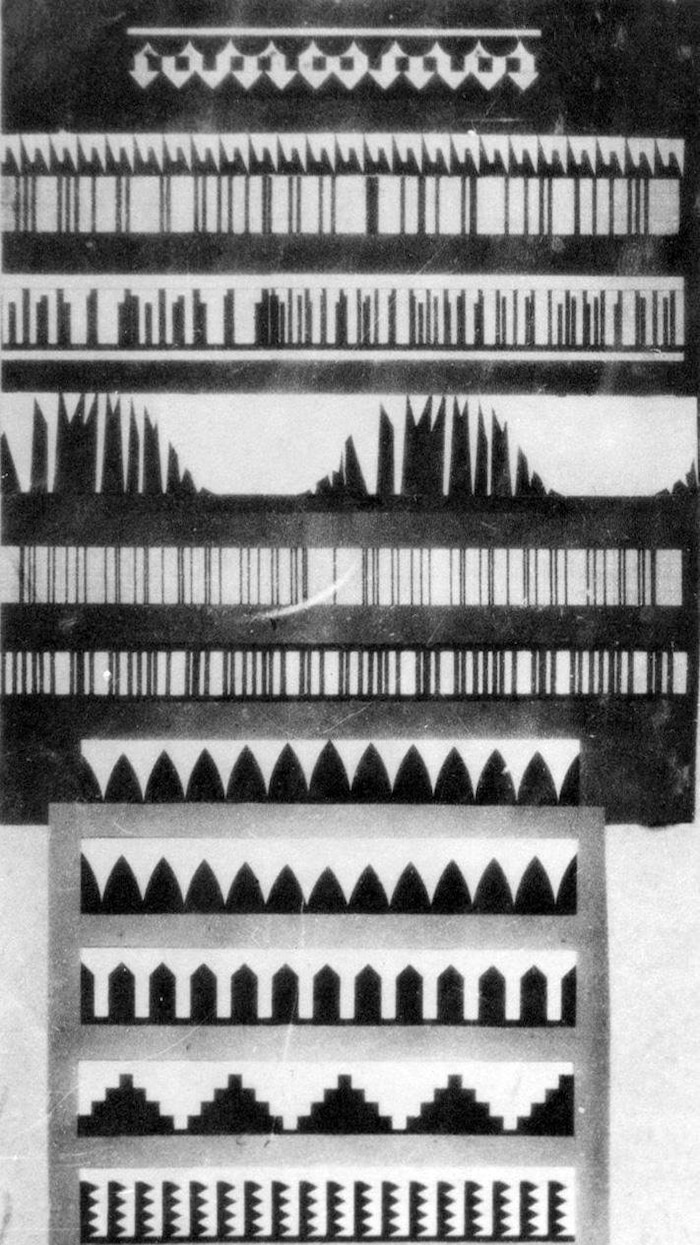
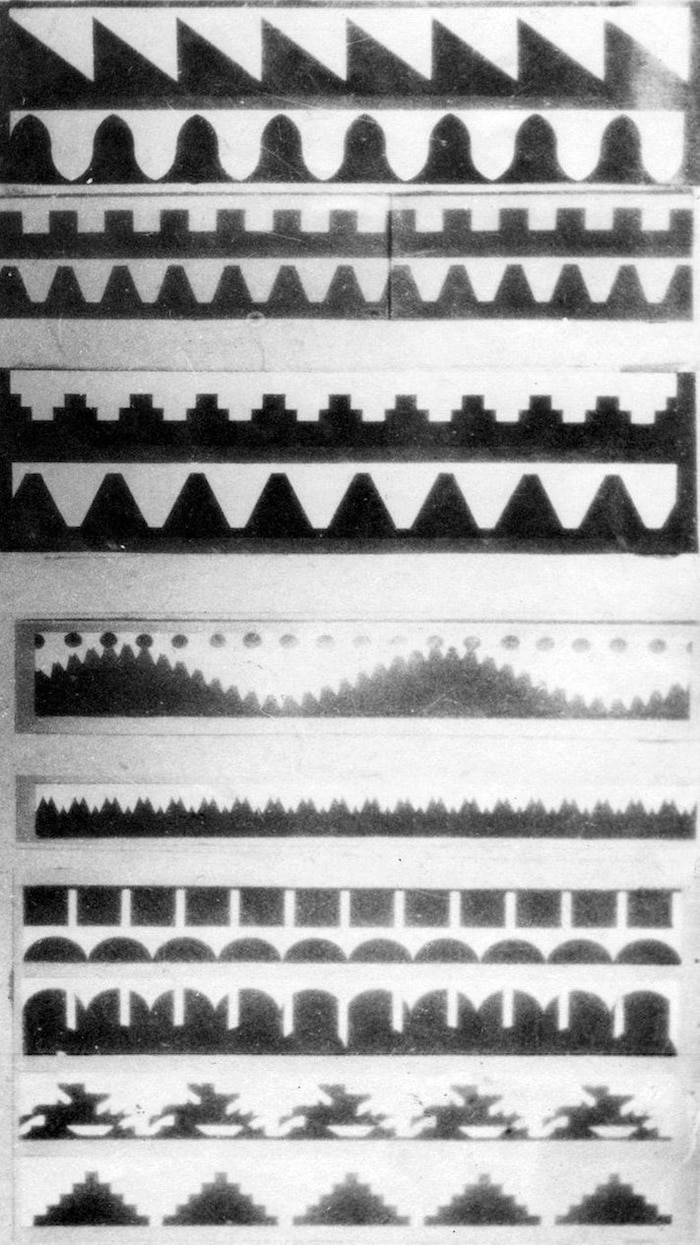
On August 20th, 1930, during the First Conference on Animation Techniques in Moscow, Avraamov demonstrated the artificially-drawn sound pieces in a presentation titled “Ornamental Sound Animation.” An article published in 1931 described the nuts-and-bolts of this stunning technique: “Instead of common sound recording on film by means of microphone and photocell, [Avraamov] simply draws geometrical figures on paper before photographing them onto the sound track of the filmstrip. Afterwards, this filmstrip is played as a common movie by means of a film projector... Being read by photocell, amplified and monitored by loudspeaker, this filmstrip turns out to contain a well-known musical recording, while its timbre is impossible to associate with any existing musical instrument. Comrade Avraamov is now conducting a study into the recording of more complicated geometrical figures. For instance, recording graphical representations of the simplest algebraic equations and drawing the molecular orbits of some chemical elements.”
Buoyed by this success, in the autumn of 1930 Avraamov founded the Multzvuk Group, which would come to serve as a prototype of modern studios dedicated to computer music. By the time it closed four years later, over 2,000 metres of ornamental sound tracks were produced. Unfortunately, nothing remains. The whole archive had been kept for several years at Avraamov’s apartment, where it is thought that sometime between 1936 and 1938, it was accidentally burned by his own sons while they were making rockets and smoke screens with the old nitro-film tapes, which were highly flammable.
Avraamov eventually relocated to Kabardino-Balkaria, then the location of the Soviet Republic in the Caucausus Mountains. (Despite his reputation as a futurist, he was likewise an expert in the folk music of this region, and considered it a national duty to revive the musical culture of the small mountain territory.)
In 1938, following four years of isolation in the Caucasus, Avraamov was given a prize of 5,000 rubles and a ticket to Kislovodsk. He returned at an inauspicious time – in 1938, Moscow was in the middle of Stalin’s Great Terror. The city was a cultural desert, with the few outstanding scholars and artists who remained occupied only with fear, ignorance and indifference. Many of Avraamov’s former colleagues from Kabardino-Balkaria were arrested. His archival documents, which he had left there, disappeared together with other archives confiscated by NKVD.
When the war began, Avraamov’s life was thrown into further turmoil. Promised the title and accompanying protections for “Honored Workers,” the Union of Soviet Composers collected documents for consideration, only for the collection to be lost, along with all extant party documents, during an emergency transport over the course of the war. Avraamov refused to evacuate his house in Moscow, as if he knew the Germans would not take the city, but it was a time of struggle. His family starved while Avraamov continued to brood over extensive creative plans, which he must have known would never come to fruition until the war was at its end.
In July 1940, leading Russian composer Mikhail Gnesin wrote a letter of support for Avraamov as part of his efforts to receive a larger pension from the state, saying that “Arseny Mikhailovich Avraamov is one of the most outstanding figures in Soviet musical art I have ever met in my life... A. Avraamov should also be recognized as a founder of Soviet musical acoustics. The majority of Soviet scholars in the field of acoustics (even having different convictions) are his pupils, or have begun their work under his influence.” It was to no avail – by this point, Avraamov’s past artistic achievements and influences were of little interest to the Soviets. He was destitute, living with his wife and ten small children in a single-roomed Moscow flat, trying to survive with no job and only a small pension.
In November 1943, Avraamov finally finished his biography for the Central Committee, which began in June: “At the American exhibition ‘World of Tomorrow’ I will show such ‘exhibits’ that America will shake, the Negroes will not hear their music in a tavern-jazz, but in ‘national in form, socialist in content.’ We will also write a real hymn of Victory not on the helplessly-childish rhymes of Mikhalkov, but on the ingenious (both in form and in content) text of some new super-Mayakovsky who in a few months will come out of my poetic studio.” According to the son of Avraamov, the letter was answered by Lavrentiy Beria, then-chief of the secret police. His message: “There is a war on, do not engage in nonsense.” Six months later, Avraamov was dead.
Long after the war was finished and the pain of Avraamov’s life was seemingly lost to history, his influence persists. In the early 1930s, Soviet researchers led by Avraamov were able to sample and synthesize the sounds of musical instruments, human voices and various noises based on artificial sounds, all the while synthesizing complex polyphonic, orchestral scores. Sequencers, multi-channel recordings, sound editing... It all sprung, at least in part, from Avraamov.
In the private archive of Avraamov’s son German, a yellow poster of a “concert-demonstration” is kept. It announces that Arseny Avraamov will perform his “music of the future.” This is one of the last pieces of remaining physical evidence of the existence of one of the most outstanding musicians of the 20th century.
Header image © *Gorn*, 1923, Vol. 9. Courtesy of Andrey Smirnov

